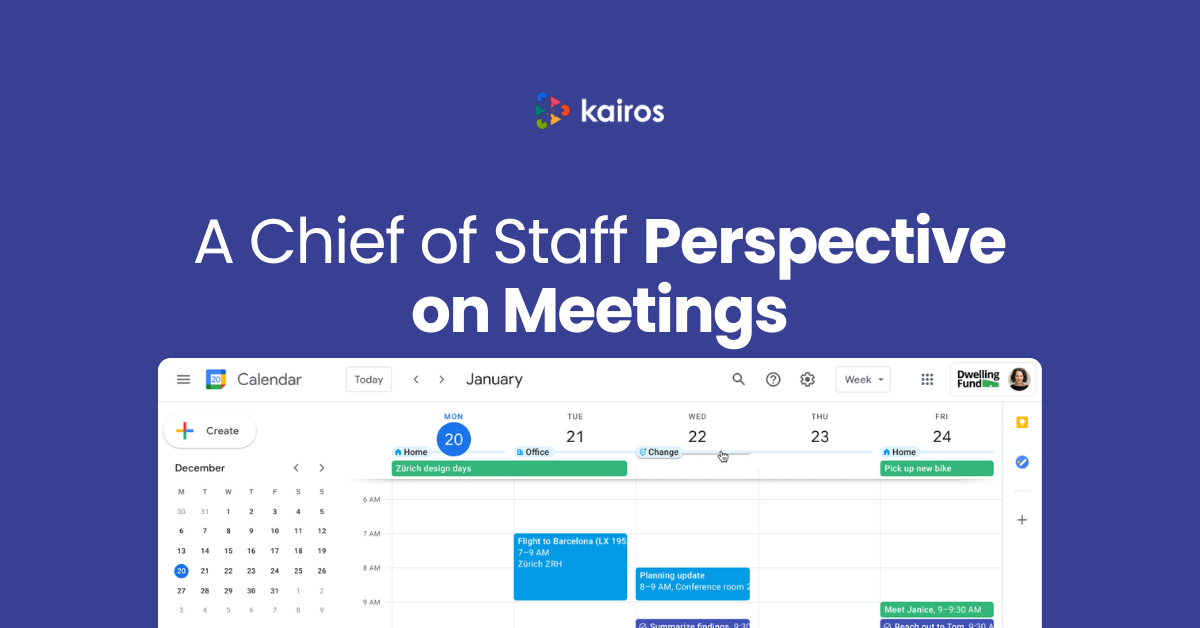What Is the Best Way to Get Rid of Unproductive Meetings?
Why are there so many unproductive meetings?
In theory, in a corporate environment, meetings play a large role in nurturing innovation and propelling teams toward success. In practice, however, they fall short of these goals. Instead of being focused and informative, meetings often veer off track; we label these deviations as unproductive meetings – meetings that the attendees do not find to have been an efficient use of their time. Unproductive meetings are marked by off-topic discussions, burdened by an excess of staff, and – in some cases – meetings that could have been replaced by an email.
So, what are meetings? Dr. Rogelberg, Chief Science Officer at Kairos and leading expert on meetings, sees them as "purposeful work-related interactions[1]," not just casual chats, but less formal than lectures. According to "Meetings In America,"[2] there are about 11 million meetings in the United States daily, and that number keeps increasing! Most employees spend six hours a week in meetings, and managers spend around 3/4 of their time planning or carrying out meetings in larger organizations.
Meetings take up a lot of our time at work, but it's hard to say what counts as unproductive. Many of us haven't been taught to use our time and resources well, which is reflected in various levels of participant meeting satisfaction. Meeting satisfaction isn't just a small factor of everyday work life; it can decide how happy people are with their jobs and affect how many people stay or leave a firm. Although companies are encouraged to assess meeting satisfaction regularly, a survey of 20 Fortune 500 organizations reveals that many still do not[3].
With so many ways to come together, meetings should be interesting and helpful. But why do so many of these 11 million meetings feel boring and unproductive?
The answer is more straightforward than you might think. It’s hard to see where our everyday work environment could improve. Figuring out what makes work unproductive can be tricky, but there are ways to fix these common problems. The first step is to understand the issues; from there, you can give your company the tools it needs to solve these problems. With some knowledge and a good understanding of what's not working in your company, you can start making changes.
Common Causes of Unproductive Meetings and Evidence-Based Remedies
|
Common Causes of Unproductive Meetings |
Evidence-Based Remedies |
|
Lack of Agenda Sometimes, we have meetings just for the sake of having them. Consider your regular check-ins or daily "let's touch base" talks. A meeting without a clear goal can feel like a waste of time; often, not much gets done. A 2020 study found that the top three reported problems in meetings were 'getting off subject,' 'no goal or agenda,' and 'too lengthy' due to a lack of enforced structure. |
Dedicated Agenda Tools To fix this, use tools like Docket or Fellow for a clear agenda. You can also use collaborative platforms such as Microsoft Teams or Google Workspace. Use agenda templates and reminders, and encourage a culture where meetings have explicit goals. Ensure the people leading the meetings know how to manage them well, and share meeting notes to ensure everyone is accountable. |
|
Deviation From Existing Agenda Straying from the plan in a work meeting is like messing up a dance routine. It's a disruption, makes everyone lose their rhythm, and even though we can get back on track, it can mess up the flow and outcomes of the meeting. The main goals of the meeting can get overshadowed, and people might need clarification. |
Staying On Track To avoid this, use tools like Microsoft Teams or Google Workspace to keep track of the agenda in real-time. Use reminders and have a place for off-topic talks that can be discussed later. Also, ensure the person leading the meeting knows how to manage it well to keep things on track. |
|
Hidden Agenda Having secret agendas in a meeting can make it hard for a team to work well together. In a forum with hidden motives, employees might feel like their managers are trying to get information instead of working together openly. |
Implement Transparency Use straightforward tools like Docket or Asana to set the agenda; this gets everyone involved. Share schedules on platforms like Microsoft Teams or Google Workspace, ask team members for their ideas before the meeting, and make sure everyone knows the goals. This helps prevent hidden motives. |
|
Too Long Anyone who has been in the corporate world for a while knows about never-ending meetings. Employees might grow bored and less excited about working together when meetings go on for too long without a good reason. |
Keep A Clock Decide on strict time limits for each part of the agenda and stick to them. Use a timer everyone can see, like MeetingTimer or Time Timer. Encourage short comments and adhere to the plan. Use meeting tools like Microsoft Teams or Google Meet that track time to keep discussions on track. |
|
Too Frequent | Too Many If meetings happen too often, they can become routine, unhelpful, and ineffective. Over time, every gathering might have a small impact, and people might start feeling tired. Managers must strike a good balance to ensure that each meeting is worth it. |
Structure, Structure, Structure! Create a schedule for meetings using tools like Google Workspace or Microsoft 365. Decide when a session is needed and check if recurring arrangements are still necessary. For less urgent talks, think about other communication methods, like Slack or Microsoft Teams. This can reduce how many meetings you need. |
|
Excessively Staffed Imagine a busy Broadway stage with many performers, all vying for their time in the spotlight. In business, having too many people in meetings can make it hard to hear essential things and decide well. Meetings should be like a well-practiced group, where each person has a specific role. Having too many voices can make discussions less decisive and disrupt the plan. |
Prioritize Necessity Having too many people in meetings can cost a lot, so only invite the most important ones – people who understand their role and will contribute to the meeting objectives. Use tools like Microsoft Outlook or Google Calendar to pick who comes and ensure everyone knows what the meeting is about. Regularly check and update the list based on the agenda to guarantee only the necessary people are there. And, ensure all participants receive the meeting notes whether they were able to attend or not. |
|
Imbalanced Participation Meetings thrive on diverse perspectives. Sometimes, though, one or two people dominate the conversation, and others don't talk at all! When this happens, creativity can suffer, and it's hard to make good decisions for the company. |
Involve Em’ All! Don't worry; tools like Mentimeter or Slido can help everyone participate. Create a place where everyone feels comfortable sharing their thoughts and use platforms like Microsoft Teams or Slack for real-time talking and feedback. |
|
Distractions Distractions, like phone buzzing, side talks, or interruptions, can mess up a meeting's primary focus. Over time, these distractions can make it hard to work together effectively and make meetings less productive. |
Tune It All Out It might seem challenging to stop outside things from messing up your meetings, but there are tools to help. Tell people to use tools like Krisp.ai to block out background noise during online sessions. Also, use video platforms like Zoom or Microsoft Teams with features to keep everyone focused, like Zoom's Focus Mode or Microsoft Teams' Together Mode. |
Who is responsible for fixing Unproductive Meetings?
And How Would They Go About It?
A successful meeting requires a trained and skilled leader who orchestrates collaboration and innovation. As the meeting steward, this leader carefully plans agendas to guide discussions, ensuring everyone understands the meeting's goals. Proficient in time management, the leader keeps discussions on track and maximizes every minute for collective progress. Their real skill is creating an inclusive atmosphere where diverse voices blend into a chorus of ideas. Despite these strengths, meeting leaders have blind spots – mostly because there are very few reliable feedback loops when it comes to how successful participants find meetings. One potential solution to this issue is to assess meetings. This can be done in any number of ways – from regular, honest inquiry to a more formal survey approach.
Another solution is to task a senior manager with the role of improving meetings across the culture – to create a sort of "Chief Meeting Officer." Meetings are a significant part of corporate life, yet they are often managed in various ways by different individuals. A Chief Meeting Officer identifies problems in the company's meeting culture and coaches’ leaders to improve over time. The challenge is that, currently, if there is no such role, there is no one who is specifically accountable for a daily cost center that can be as expensive as an organization’s entire technology budget.
Reducing Unproductive Meetings Across Your Culture Is Possible
But, It Requires Focus and Time
The culture you create at your company and the people you work with shape how meetings happen. That said, transforming corporate meetings from dull to super-productive is a process that takes time, not something that happens overnight. It means a commitment to track essential data, listen to employees' thoughts, and try new ideas to change the bigger picture of how meetings work. This significant change ensures the good things you start doing become essential and integral parts of your company's work, making the workplace more lively and efficient over time.
It's not impossible, but it can be tricky. If you're serious about stopping unproductive meetings in your company, Kairos is an excellent solution. Kairos Learning Labs gives a way to improve your meeting culture by offering tools, training, and tests to boost working together, use time well, and improve your company culture. We'll show your meeting leaders and managers different tools, from software that stops unnecessary meetings and time-wasting, to employee assessments, and even hands-on training from MIT and UNC Charlotte expert coaches.
While corporate meeting optimization might seem hard at first, it can be achieved and have an outstanding return and impact across your entire company. Being intentional and using scientific insights can make meetings more accessible, productive, and engaging. By using these insights and special tools and chipping away every day towards improvement, Kairos offers the best opportunity for companies to change their meeting culture—one meeting at a time.
REFERENCES
[1] Rogelberg, S. G. (2006). Meetings at Work. In Rogelberg, S. G. (Ed.), The Encyclopaedia of Industrial and Organizational Psychology, (pp. 474–475) Sage Publishing, California.
[2] van Vree, W. (2011)Meetings: The Frontline of Civilization. The Sociological Review, 59(1)
[3] Rogelberg, S. G., Allen, J. A., Shanock, L., Scott, C. W., Shuffler, M. (2010). Employee satisfaction with their meetings: A unique predictor of job satisfaction. Human Resource Management, 49(2), 149–172.
We're Here to Help. We'll Make it Easy.
We understand that improving meetings can be difficult, which is why we exist. Talk to one of our Kairos specialists today to get started on the path to happier employees who value the time they spend in meetings.
.png)

